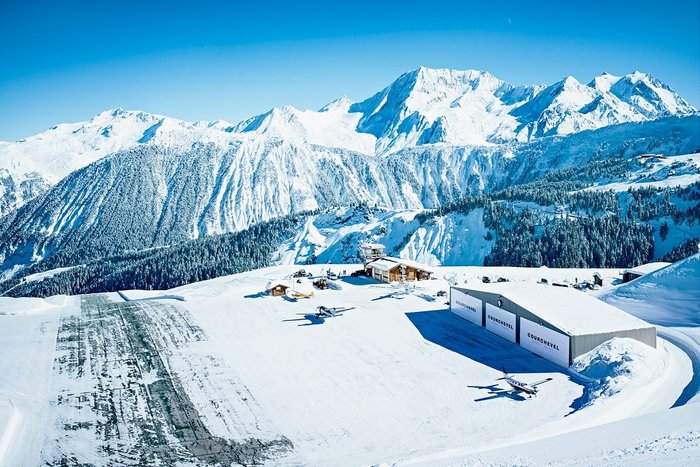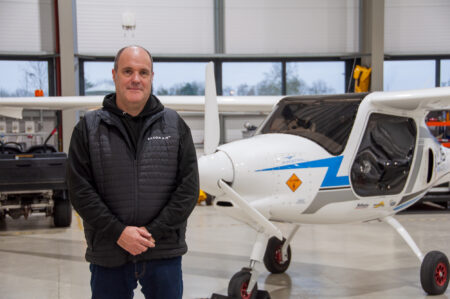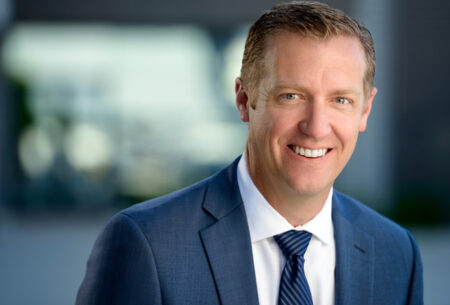Courchevel Altiport (LFLJ) is situated in the picturesque setting of the French Alps, nestled within the mountains and serving its namesake ski resort. The airport is famed for its short runway, which measures just 537m (1,760ft) and has a gradient of 18.66% to help slow aircraft landing in icy conditions. It is thought to be the steepest runway in the world.
Jean-François Deltour has been airport manager at Courchevel since November 2017, after previously serving as deputy manager of the airport and airport manager at Quiberon Airport in western France. His passion for all things aviation blossomed as a child, leading him to pursue a career in the industry.
“I have loved aviation since my childhood,” says Deltour. “After studying for management qualifications, I decided to specialize in air transport. At the end of my studies in 2013, I completed an internship at Saint- Tropez Airport, where I was in charge of different projects such as the protection of the platform against floods and Global Navigation Satellite System implementation. My role at Courchevel Altiport was a logical next step in my career.”
The airport sits at an altitude of 2,007m (6,590ft), providing easy access for passengers heading to the nearby popular ski resort. During winter, Courchevel Altiport experiences around 6,500 aircraft movements on average, dropping to around 1,000 movements for the summer season in July and August. January, February and March account for 70% of all winter flight movements, with around 70 flights landing and departing each day.
“Skiing isn’t the only reason people fly to Courchevel,” says Deltour. “Customers often come for a sightseeing flight over the Alps, skydiving and for the flight school. It is also popular for those wishing to visit the local palaces, famous hotels, restaurants, spas, luxury shops and beautiful surrounding nature.”
Snowy scenes
Being situated at such a high altitude brings challenges to Deltour’s role as manager that most airport bosses would never have to face. Courchevel regularly experiences temperatures of around -15°C (5°F). Heavy snowfall and turbulent weather is frequent.
A recent airplane crash at the airport at the top of the runway demonstrates the challenging environment that the airport sits within. There were no serious injuries, but the aircraft was severely damaged.
“The weather can change really quickly,” says Deltour. “We can have bad weather in the morning with fog, clouds and wind, but great weather in the afternoon. This creates challenges that are unique to an airport such as Courchevel as snow needs to be constantly cleared from the runway to keep it safe for take-offs and landings.
“We overcome this with great expertise from a competent, involved and motivated team that is trained and skilled in multiple roles. We all work together to make our customers happy and ensure everyone’s safety.”
These unique challenges mean not all business aircraft can fly to the airport. The most common airplane at the hub is the Pilatus PC-12, which Deltour believes to be the best aircraft for landing on short runways.
Other jets that are popular with business travelers, such as Falcon and Citation offerings, are banned from the airport because of the short, challenging runway and noise abatement regulation.
However, all types of helicopters can land at Courchevel and they account for 70% of all flight activity during the peak winter season. Many helicopters landing at Courchevel are direct transfers from the nearby airports of Chambery, Grenoble, Geneva or Annecy, which can accommodate a wider variety of jets.
Customer care
Around 10,000 passengers arrive at the airport every winter. Courchevel Altiport has plans to evolve its current customer offering to meet growing passenger demand. Recent developments include refreshed runway markings and a new reception desk, but there are bigger plans in the pipeline.
“In order to become a popular business aviation destination around the world, we are looking to expand as much as possible,” comments Deltour. “We are planning to construct a business aviation terminal with all associated services such as hangar space, concierge and catering – hopefully one day becoming IS-BAH certified. We will do everything internally and we will not use an FBO brand, instead creating our own brand. We hope that all will be operational for the World Ski Championships in 2023.
“I also want to improve the skills of our employees, join prestigious institutions such as the EBAA, refresh the airstrip, and enlarge our site infrastructure by adding more heliports and car parking areas,” he adds.
Deltour predicts there is strong growth potential at the airport, with increases in helicopter traffic; boosted staff competence and therefore improved customer experiences; and improved aircraft performance such as quieter and greener jets, more comfortable aircraft with new embedded technologies, and less fuel consumption.
“What is important to me is increasing long-term customers’ loyalty,” he says. “In 2019, I also hope to see an increase in flight movements, no serious accidents, and I would like to create events such as seminars, meetings, public air events, unions of business aviation airports and open days at the airport to attract more people to the beautiful destination of Courchevel.”





